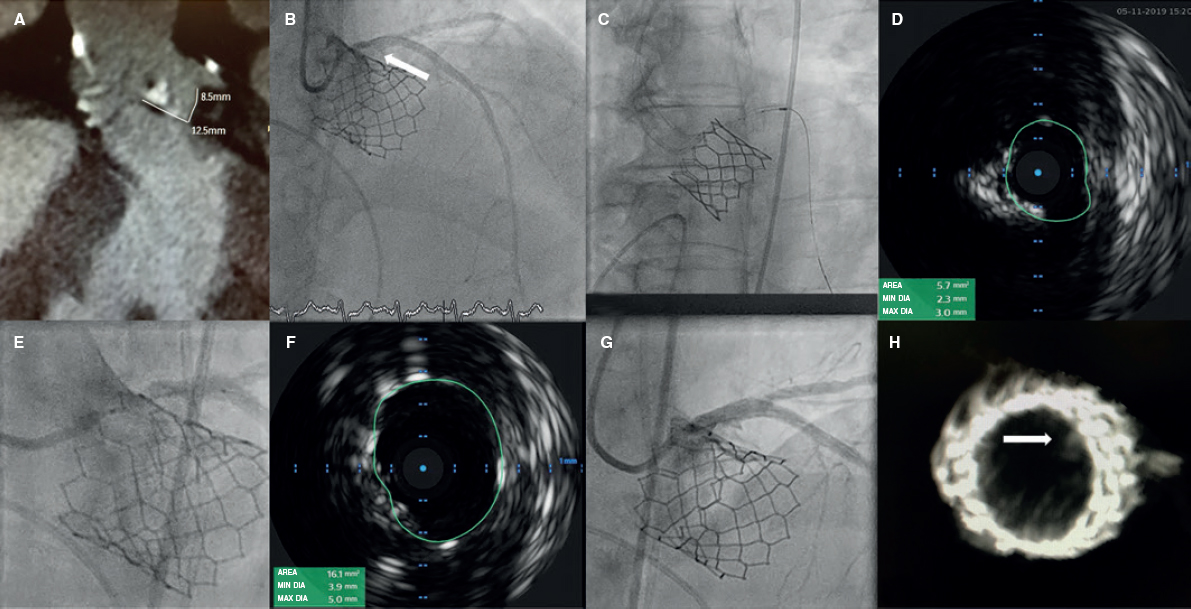A 76-year-old male was admitted to undergo a transfemoral aortic valve implantation. Left main coronary artery (LMCA) was low (8.5 mm) with a long (12.5 mm) and thick left leaflet in the aortic valve (figure 1A), and small aortic sinuses, therefore the LMCA was protected with a guidewire. After implanting an Edwards-S3 valve (N29; -1cc) and despite patent LMCA with normal coronary flow the coronary angiography still showed inconclusive images (arrow, figure 1B and video 1 of the supplementary data).

Figure 1.
Intravascular ultrasound (IVUS) was performed, but the transducer could not be crossed easily because the guidewire was jailed. Using the therapeutic introducer, we were able to engage the LMCA through the prosthesis open cells (figures 1C,D and videos 2, 3 of the supplementary data). The IVUS confirmed the presence of ostial LMCA compromise (area: 5.7 mm2) by the native leaflet. Stent implantation (4 x 12 mm with 5 x 10 mm proximal optimization) was decided with a slight stent-protrusion inside the valve (figure 1E and video 4 of the supplementary data). The IVUS and the angiography confirmed the good results (figure 1F,G and video 5 of the supplementary data) and the patient was discharged 3 days later. Informed consent was obtained from the patient for the publication of his case.
Currently, coronary artery compromise is a growing concern. To prevent it consider careful sizing, a proper ring-sinuses-leaflet length in relation to the coronary ostia, wire protection or even using the snorkel/chimney technique. Still, late occlusions have been reported. Our patient illustrates the value of IVUS to decide how to treat these compromised ostia possibly avoiding this late complication. On the other hand, compared to the snorkel technique the “ping-pong” technique allows a safe stenting inside the stent of the prosthesis (arrow, figure 1H), causes less distortion to its structure, and facilitates access to the coronaries in the future.
FUNDING
None.
AUTHORS' CONTRIBUTION
I.J. Núñez-Gil: conceptualization, case operator, preparation of the manuscript, and image processing. R. Vera: case operator, revision of the manuscript, and processing of computed tomography. P. Jiménez-Quevedo and L. Nombela-Franco: critical review of the manuscript. A. Fernández-Ortiz: case operator and critical review of the manuscript.
CONFLICTS OF INTEREST
None.
SUPPLEMENTARY DATA
Video 1. Núñez-Gil I. H. DOI: 10.24875/RECICE.M20000120
Video 2. Núñez-Gil I. H. DOI: 10.24875/RECICE.M20000120
Video 3. Núñez-Gil I. H. DOI: 10.24875/RECICE.M20000120
Video 4. Núñez-Gil I. H. DOI: 10.24875/RECICE.M20000120
Video 5. Núñez-Gil I. H. DOI: 10.24875/RECICE.M20000120
* Corresponding author: Departamento de Cardiología Intervencionista, Hospital Clínico San Carlos, Prof. Martín Lagos s/n, 28040 Madrid, Spain.
E-mail address: ibnsky@yahoo.es (I.J. Núñez-Gil).











